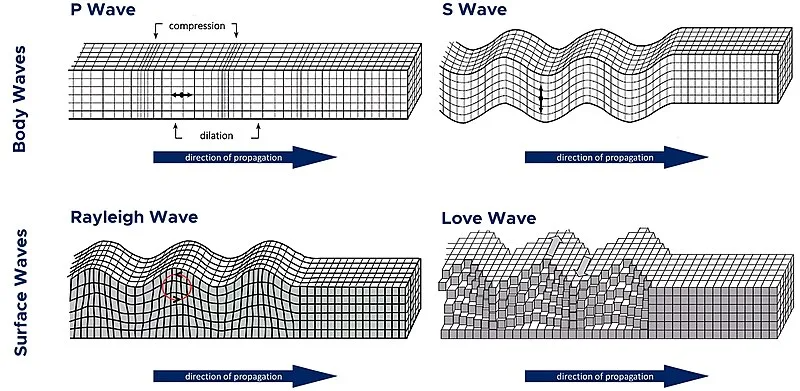September 26th Current Affairs
Table of Contents
Kannada Literature Optional Syllabus
Home / ಐಚ್ಚಿಕ ಕನ್ನಡ ಸಾಹಿತ್ಯದ ಪಠ್ಯಕ್ರಮ ಐಚ್ಚಿಕ ಕನ್ನಡ ಸಾಹಿತ್ಯ ಪತ್ರಿಕೆ – 1 ವಿಭಾಗ – ಎ ಅ) ಕನ್ನಡ ಭಾಷೆಯ ಚರಿತ್ರೆ ಭಾಷೆ
UPSC Current Affairs – October 6th
October 06th Current Affairs Home / Table of Contents 36-hour curfew imposed in parts of Odisha’s Cuttack over communal tensions
Religious Minorities in India and the Challenge of Communal Harmony: A Sociological Reflection on the Cuttack Violence
Home / Religious Minorities in India and the Challenge of Communal Harmony: A Sociological Reflection on the Cuttack Violence Sociology
UPSC Current Affairs – October 4th
October 04th Current Affairs Home / Table of Contents Isabgol Processors threaten to halt purchases from October 6th over GST
Sologamy and Contemporary Trends in Marriage: A Sociological Perspective
Home / Sologamy and Contemporary Trends in Marriage: A Sociological Perspective Sociology Paper 1: Systems of Kinship – Contemporary trends
UPSC Current Affairs – October 3rd
October 03rd Current Affairs Home / Table of Contents NASA IMAP to show how solar particles are energised and shield
Understanding Indian Festivals through Durkheim: Religion, Rituals, and Collective Conscience
Home / Understanding Indian Festivals through Durkheim: Religion, Rituals, and Collective Conscience Sociology Paper 1: Émile Durkheim – Religion and
UPSC Current Affairs – September 30th
September 30th Current Affairs Home / Table of Contents Ladakh groups reject talks with government, Ministry says open to dialogue
Caste Census in India: A Sociological Perspective
Home / Caste Census in India: A Sociological Perspective Sociology Paper 2: Caste System – Features of Caste system. The
Constitutional Morality: Upholding India’s Democratic Ethos
Home / Constitutional Morality: Upholding India’s Democratic Ethos Sociology Paper 2: Visions of Social Change in India – Constitution, law,
Banks should work to be in global top 10, fund small & medium firms: Amit Shah
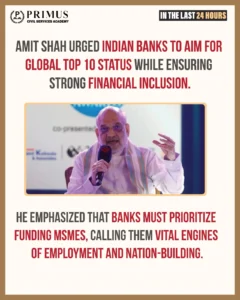
Relevance to UPSC
GS Paper III: Economy
- Pertains to financing, especially MSME financing as a growth lever.
- Links to issues in the banking sector health like NPAs, recapitalisation, stress resolution, and reform outcomes.
More About the News
- Union Home Minister Amit Shah, speaking at the Financial Express Best Banks Awards, urged Indian banks to aim for being among the global top 10 in scale and stature.
- He emphasized that banks must prioritise funding to MSMEs (micro, small & medium enterprises), calling them “key to nation-building” and said the government would stand guarantee for them.
- He also referred to the government’s reforms like removal of compliance burden (40,000 compliances removed), structural/digital reforms, focus on financial inclusion, reduction of NPAs, and integration of welfare schemes to support growth.
Micro, Small & Medium Enterprises (MSME)
Micro, Small, and Medium Enterprises (MSMEs) form the backbone of India’s economy, contributing significantly to employment, exports, and regional development. With their agility and innovation, MSMEs drive inclusive growth while supporting larger industrial ecosystems. Strengthening this sector is crucial for achieving India’s vision of sustainable and self-reliant economic development.
Statutory Provisions Governing MSMEs in India
Micro, Small and Medium Enterprises Development (MSMED) Act, 2006:
- Provides legal recognition, promotion, and development framework for MSMEs.
- Defines classification of micro, small, and medium enterprises (manufacturing & service sectors).
- Mandates the facilitation of credit, technology, marketing, and infrastructure support.
- Establishes development councils for various sectors to promote policies and schemes.
Companies Act, 2013 (Section 134 & 188):
- Requires disclosure of transactions with related MSME entities to enhance transparency.
Important Data Sets:
- Number of MSMEs (2023-24): 63 million enterprises
- Employment generated: 110 million people
- Contribution to GDP: 30%
- Exports share: 48% of total exports
- Women-owned MSMEs: 13%
Classification of MSMEs
Type | Old Criteria (Investment in Plant & Machinery / Equipment) | New Criteria (Investment + Turnover) |
Micro | Investment ≤ ₹25 lakh | Investment ≤ ₹1 crore & Turnover ≤ ₹5 crore |
Small | Investment ≤ ₹5 crore | Investment ≤ ₹10 crore & Turnover ≤ ₹50 crore |
Medium | Investment ≤ ₹10 crore | Investment ≤ ₹50 crore & Turnover ≤ ₹250 crore |
MSME Day
- MSME Day is observed globally on June 27, officially designated by the United Nations in 2017 through Resolution A/71/279.
- The day recognises the vital role of small businesses in achieving Sustainable Development Goals (SDGs) worldwide.
- In India, it is celebrated as “Udyami Bharat – MSME Day”, highlighting the nation’s entrepreneurial spirit.
- The 2025 theme, “Enhancing the role of MSMEs as drivers of Sustainable Growth and Innovation”, reflects the sector’s growing role in economic transformation.
- For UPSC preparation, understanding this theme links economic growth with environmental sustainability, a key focus in contemporary governance.
Role of MSME Sector in India’s Growth
- Employment Generation: MSMEs employes 110 million people.
- Export Promotion: MSMEs contributes to 48% of India’s exports. e.g., leather and handicraft exports from Agra.
- Innovation and Entrepreneurship: Many startups emerge from the MSME ecosystem. e.g., IT services startups in Bengaluru.
- Regional Development: MSMEs support rural & semi-urban economies. e.g., handloom clusters in Varanasi.
- Industrial Support: MSMEs act as ancillary units to large industries. e.g., auto component suppliers in Pune supporting OEMs.
Issues Hindering MSME Growth
- Access to Finance: Limited credit. e.g., delayed loan approvals under traditional banking.
- Infrastructure Deficits: Poor connectivity, power shortages. e.g., rural manufacturing units face logistics issues.
- Technology Gap: Low adoption of digital/automation. e.g., traditional handicraft units lag in e-commerce.
- Regulatory Burden: Complex compliance & GST issues; e.g., small enterprises struggle with filing returns.
- Market Access – Limited domestic & global reach; e.g., micro-enterprises lack brand recognition.
Government Initiatives
- MSME Samadhaan & MSME Sambandh to address delayed payments
- Credit Guarantee Fund Trust (CGTMSE) for Collateral-free loans
- Udyam Registration Portal for ease of registration
- Prime Minister Employment Generation Programme (PMEGP) to encourages new ventures
- Technology Centres & Incubators to upgrade skills and innovation
Recommendations by Popular Committees
- Rangarajan Committee (2011): Suggested better access to credit, digital adoption, and marketing support
- Dr. J. S. Anand Committee: Focused on enhancing MSME competitiveness, easing financial burden, and encouraging technology adoption
Way Forward
- Encourage digital adoption & Industry 4.0 integration
- Strengthen access to affordable finance and insurance
- Promote MSME clusters and export facilitation
- Simplify regulatory compliance & GST processes
- Foster entrepreneurship and skill development in rural areas
Prelims MCQ
Q. Consider the following statements regarding the new MSME classification in India: 1. Both investment in plant & machinery and turnover are used in the new criteria. 2. A medium enterprise can have a turnover of up to ₹250 crore. 3. Micro enterprises are allowed an investment of up to ₹25 lakh under the new criteria. Which of the above statements is/are correct?
A. 1 and 2 only
B. 2 and 3 only
C. 1 and 3 only
D. All of the above
Mains Question
Q. Micro, Small, and Medium Enterprises (MSMEs) are critical to India’s economic growth, but face structural and financial challenges. Critically analyze the role of MSMEs in employment, innovation, and exports, and suggest measures to strengthen this sector.
After Opposition push, EC restores old rule: EVM tally only after postal ballots
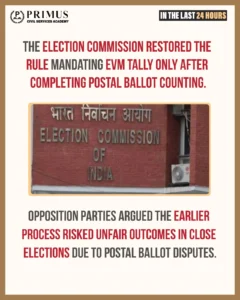
Relevance to UPSC
GS Paper II: Polity & Governance
- Illustrates the working and powers of the Election Commission of India — its rule-making, policy reversals, and response to stakeholder pressure.
- Raises questions of electoral integrity, transparency, and procedural fairness in India’s democratic institutions.
- Demonstrates how checks and balances, opposition voice, and institutional accountability play out in practice.
More About the News
- The Election Commission (EC) has reversed its 2019 change and reinstated the rule that the penultimate round of EVM/VVPAT counting cannot begin until all postal ballots are counted.
- The 2019 rule had de-linked postal-ballot counting and EVM counting to speed up results, but opposition parties argued it undermined fairness in tight contests.
- The EC’s new instruction mandates that in counting centres, EVM counting must await postal ballot completion; only in centres where postal ballot counting is done can EVM counting proceed.
Election Commission of India (ECI)
The Election Commission of India (ECI) is the constitutional body entrusted with conducting free and fair elections to Parliament, State Legislatures, the offices of President and Vice-President, and supervision of the electoral machinery. Over decades it has evolved from a small administrative office into a powerful, technology-driven electoral regulator tasked with preserving democratic legitimacy. Its impartial functioning is central to the health of Indian democracy.
Evolution
- 1950 — ECI created under Article 324 of the Constitution (initially a single CEC).
- 1960s–1970s — Expanded administrative capacity as Indian elections grew in scale.
- 1990s–2000s — Reforms: introduction of Electronic Voting Machines (EVMs), Voter ID cards, statutory measures to strengthen process integrity.
- 2010s–2020s — Greater use of technology (EVM-VVPAT pairing, digital roll management), Model Code of Conduct institutionalisation, voter awareness drives.
Constitutional & Non-Constitutional Provisions
- Constitutional Provisions:
- Article 324 — vests the power of superintendence, direction and control of elections in the ECI; establishes it as a constitutional body.
- Non-constitutional Provisions:
- Detailed operational rules, conditions of service, and many procedural aspects derive from statutes (e.g., Representation of the People Act, 1951), rules, and executive orders. Recent bills seek to codify appointment/terms further.
Roles & Functions
- Conduct free and fair elections to Parliament and State Legislatures, and supervise electoral administration.
- Prepare and revise electoral rolls, including deletions, additions and SIR (Special Intensive Revision) operations.
- Enforce the Model Code of Conduct (MCC) during elections.
- Regulate political party recognition, symbols and candidate nominations; monitor election expenditure.
- Implement technology solutions (EVMs, VVPAT) and grievance redressal; undertake voter education.
Notable Works / Initiatives
- Introduction and nationwide roll-out of EVMs + VVPATs to improve transparency and speed.
- Model Code of Conduct (MCC) — binding electoral ethics and conduct for parties & candidates.
- Systemic reforms & voter services — National Voters’ Day, electoral literacy, voter facilitation portals and grievance systems.
- Recent set of process reforms / 23–28 new initiatives announced to strengthen electoral processes and logistics (ECI press outputs).
Recent Amendments
- Legislative attempts to codify appointment/term/conditions: Aiming to clarify qualifications, method of appointment and tenure. These have generated debate on institutional independence.
- Administrative reforms & new initiatives (2024–25): a package of process reforms, digital enhancements and capacity-building measures announced by ECI to improve electoral logistics.
Appointment, Tenure & Removal
- Appointment: Chief Election Commissioner (CEC) and Election Commissioners (ECs) are appointed by the President of India (convention: on the recommendation of the Union government); the exact consultative procedure is not laid down in the Constitution.
- Tenure/Removal: CEC/ECs enjoy protections similar to Supreme Court judges regarding removal—removal of CEC requires impeachment (two-thirds) for proven misbehaviour or incapacity; removal of other ECs is subject to rules that aim to preserve independence. Recent bills propose clearer service conditions.
Relation with the Representation of the People Act, 1951 & Model Code of Conduct
- RPA, 1951: Principal statutory framework for conduct of elections (qualification/disqualification of MPs/MLAs, corrupt practices, return of election, by-elections). ECI enforces provisions of the RPA through electoral administration and prosecution referral.
- Model Code of Conduct (MCC): A non-statutory but binding set of norms enforced by ECI during elections to ensure ethical conduct by parties and candidates. MCC is enforced administratively (censure, warnings, show-cause notices) and is central to daily ECI functioning.
Recent Issue: Special Intensive Revision (SIR)
- SIR controversy (Bihar and other states) — ECI’s Special Intensive Revision of rolls led to mass deletions/queries, civil society and some parties challenged transparency and legality, Supreme Court involvement followed to adjudicate fairness and to direct ECI on disclosure/claims procedures. This raised issues of procedure, transparency and the judicial review of ECI actions.
Benefits of having ECI
Independent Electoral Arbiter: Secures free and fair elections.
Example: Peaceful conduct of large-scale national elections since 1952.Standardised Electoral Procedures: Nationwide EVM and VVPAT rollout standardises voting and reduces fraud risk.
Electoral Integrity via MCC: Model Code of Conduct curbs overt misuse of official machinery during campaigns.
Voter Empowerment & Inclusion: Initiatives like National Voters’ Day, simplified registration, and grievance portals increase participation.
Dispute Prevention & Confidence: By acting as a neutral administrator, reduces post-poll disputes and ensures legitimacy of government formation.
Impacts made by ECI
- Mass-scale electoral management: Efficient conduct of multi-phase general elections across diverse geographies.
- Technological modernisation: EVMs & VVPATs have sped voting and counting and enhanced verifiability.
- Promoting voter awareness: Electoral literacy and targeted drives have improved enrolment (National Voters’ Day).
- Electoral discipline: MCC enforcement curbs blatant misuse of state resources during campaigns.
- Judicial-administrative interface: ECI’s decisions are regularly tested in courts. Example: Recently Supreme Court heard the Bihar’s SIR Issue and delivered it’s Orders.
Challenges & Criticism
Perception of Political Influence in Appointments: Criticism that the appointment procedure lacks transparency, raising doubts about independence.
Example: Debate around bills to codify appointment.Transparency in Roll Revision (SIR): Allegations of arbitrary deletions have led to litigation and criticism.
Enforcement Limits of MCC: Since MCC is not statutory, punishments are mostly administrative (like censure) rather than legal, prompting calls for stronger authority.
Technological Distrust & Misinformation: Persistent scepticism around EVMs/VVPATs despite court vindications, requiring continuous public confidence-building.
Operational Challenges in Large/Fragile Settings: Ensuring free and fair voting in conflict zones, remote areas, or during pandemics involves massive logistical and security challenges.
Best practices
- Automatic & Continuous Voter Registration Elections, Canada: Continuous voter list maintenance & data matching to keep rolls updated.
- Independent Appointment Panels / Transparent Selection, Electoral Commission for Northern Ireland / UK: Transparent selection processes to strengthen institutional independence).
- Electoral Technology Testing Labs Electoral Commission, UK: Independent testing and certification of voting technology before deployment.
- Voter Education & Inclusive Outreach Programmes, Australian Electoral Commission (AEC): Targeted outreach for indigenous and remote voters.
Way Forward
- Codify transparent appointment/tenure norms while preserving constitutional independence (legislative clarity with safeguards).
- Enhance transparency in roll revisions: publish clear criteria, maintain audit trails and easy redressal for deletions (learn from judicial directions in SIR cases).
- Statutory backing for stronger MCC enforcement or clearer legal remedies for MCC violations.
- Strengthen technology audit & public communication to build trust in EVM/VVPAT and other digital tools.
- Capacity building & international best-practice adoption for roll maintenance, cyber-security, and logistics management.
As Indian democracy grows in scale and complexity, the ECI must combine constitutional independence with modern administrative transparency. Institutional reforms that strengthen appointments, technological audits and roll-management transparency will be central to preserving electoral legitimacy. A resilient, well-resourced ECI will remain the bedrock of popular sovereignty in India.
Prelims MCQ
Q. Consider the following statements regarding the Election Commission of India (ECI): 1. The ECI is a constitutional body under Article 324 of the Constitution. 2. The Chief Election Commissioner and other Election Commissioners are appointed by the President of India. 3. The decisions of the ECI are subject to approval by the Parliament. 4. The ECI has the power to supervise, direct, and control elections to Parliament, State Legislatures, and the offices of President and Vice-President. Which of the above statements is/are correct?
A. 1 and 2 only
B. 1, 2 and 4 only
C. 2 and 3 only
D. All of the above
Mains Question
Q. The Election Commission of India plays a pivotal role in ensuring free and fair elections, yet faces challenges in the modern era. Critically examine the powers, functions, and autonomy of the ECI, and suggest reforms to strengthen electoral governance in India.
Ladakh MP: ‘If Govt claims Leh violence was planned, why did they allow it? Sonam Wangchuk can’t be blamed’

Relevance to UPSC
GS Paper II: Polity & Governance (Rights / Constitutional Provisions / Federalism)
- Raises issues regarding autonomous governance in tribal areas, especially the plea to include Ladakh under the Sixth Schedule of the Constitution.
- Demonstrates centre–state, bureaucratic control, and demands for local self-governance in union territories.
- Engages with the rights of citizens, especially in a union territory, and how administrative decisions affect democratic freedoms and procedural justice (fair inquiry, protection of protest rights).
GS Paper III: Internal Security
- The region of Ladakh is strategically significant (border with China); unrest and governance issues there can have implications for security and policy stability.
- Unrest in such areas connects to challenges of law and order, protest management, and escalation control in remote and sensitive zones.
More About the News
- After protests in Leh turned violent and police firing left people dead, Ladakh Lok Sabha MP Mohmad Haneefa questioned the official narrative, asking if the government knew the violence was “planned,” why it allowed it, and defended Sonam Wangchuk’s non-violent past.
- Haneefa said that police firing was “unwarranted,” demanded a fair and impartial inquiry, and rejected assigning blame to Wangchuk, stating his statements had been peaceful till now.
- He reiterated calls to place Ladakh under Sixth Schedule status (to protect tribal autonomy) and urged the Centre to ensure local democracy instead of being run by bureaucrats.
Sixth Schedule
The Sixth Schedule of the Indian Constitution provides for the administration of autonomous tribal areas in certain North-Eastern states. It seeks to preserve tribal identity, ensure self-governance, and empower local communities while integrating them into India’s democratic framework. Strengthening its implementation is crucial for inclusive development and political stability in tribal regions.
Evolution of the Sixth Schedule
- Introduced in the Constituent Assembly debates, inspired by traditional tribal self-governance systems in Northeast India.
- Part of the original Constitution (Article 244(2) and Schedule VI) to protect tribal autonomy and land rights.
- Initially applied to Assam, Meghalaya, Tripura, and Mizoram; later extended to other tribal districts with presidential notification.
Features of the Sixth Schedule
- Autonomous District Councils (ADCs): Local legislative and executive powers for tribal areas.
- Legislative Powers: ADCs can make laws on land, forests, water, agriculture, village administration.
- Judicial Powers: Councils can establish courts for trial of certain cases involving tribal members.
- Financial Autonomy: Councils have powers to levy taxes and manage funds for local development.
- Coordination with State: Councils function under guidance of state governor for administrative harmony.
Powers & Provisions
- Legislative: Make laws on land management, forest use, water resources, and village administration.
- Executive: Implement laws, manage local services, and control resources within council area.
- Judicial: Set up courts to adjudicate disputes among tribal members (subject to state laws).
- Financial: Levy taxes, collect fees, receive grants from state/government of India.
- Administrative: Form committees for planning and development of villages/tribal areas.
Importance of Sixth Schedule
- Preserves Tribal Identity: Protects traditional governance and customs. e.g., Khasi Jaintia Hills in Meghalaya.
- Promotes Local Governance: ADCs empower grassroots democracy. e.g., autonomous councils in Mizoram manage villages.
- Land & Resource Rights: Ensures community control over land/forests. e.g., Tripura tribal land protection.
- Conflict Resolution: Judicial powers allow local dispute settlement. e.g., village courts in Arunachal Pradesh.
- Socio-Economic Development: Enables locally planned projects. e.g., tribal education and health initiatives in Assam.
Issues Faced
- Limited Financial Resources: Councils often depend on state/government grants. e.g., underfunding in Meghalaya ADCs.
- Political Interference: State governments sometimes undermine autonomy. e.g., administrative delays in Mizoram.
- Ethnic Conflicts: Overlapping jurisdictions cause inter-tribal disputes. e.g., clashes in Bodoland region.
- Implementation Gap: Laws passed by ADCs are not always executed effectively. e.g., land regulation violations in Assam.
- Modernization Pressure: Balancing tradition with development. e.g., infrastructure projects conflicting with customary land use.
Way Forward
- Enhance financial autonomy and grant adequate funds for ADC projects.
- Strengthen capacity building for council members in administration, planning, and governance.
- Ensure effective coordination between state governments and ADCs.
- Modernize governance while preserving tribal customs and traditions.
- Promote participatory development and local accountability mechanisms.
Prelims MCQ
Q. Consider the following statements regarding the Sixth Schedule of the Indian Constitution:
1. It applies to tribal areas in North-Eastern states.
2. Autonomous District Councils have legislative, executive, and judicial powers.
3. Sixth Schedule areas cannot levy taxes under any circumstances.
4. The Governor of the state has a role in coordinating with councils.
Which of the statements is/are correct?
A. 1 and 2 only
B. 1, 2 and 4 only
C. 2 and 3 only
D. All of the above.
Sixth Schedule applies to tribal areas in the North-East (1), and councils have legislative, executive and judicial powers (2). The Governor coordinates with councils (4). Statement 3 is incorrect: councils can levy taxes.
Mains Question
Q. The Sixth Schedule of the Indian Constitution aims to preserve tribal autonomy while integrating governance with the state framework. Critically analyze its effectiveness, challenges faced by Autonomous District Councils, and suggest reforms for strengthening tribal self-governance in India.
41 pro-Kannada activists arrested for storming Hindi Diwas event in Bengaluru
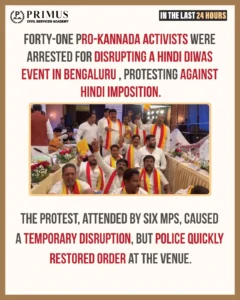
Relevance to UPSC
GS Paper I: Culture & Social Diversity (Identity Language)
- Illustrates linguistic diversity and conflict in India, the clash between Hindi and regional languages as an identity marker.
- Useful in essays or questions on “Unity in Diversity” & how policy and social dynamics must accommodate language pluralism.
GS Paper II: Polity & Governance (Rights / Language Policy / Constitutional Provisions)
- Raises the question of official language policy in India, linguistic federalism, and the balance between national and regional languages.
- Connects to fundamental rights and cultural rights, especially Article 29 & 30 (protection of culture, language) and Article 351 (directive on official language).
- Highlights centre–state tensions and public perception in implementing official language policy — the issue of perceived “imposition” and its political cost.
More about the News
- Around 41 pro-Kannada activists (from Karnataka Rakshana Vedike, KRV) were arrested in Bengaluru after they barged into a Hindi Diwas event at a five-star hotel and raised slogans against “Hindi imposition.”
- The event was organized by the Parliamentary Committee on Official Language (under MHA’s Rajbhasha Samiti), and was disrupted, after which police intervened and restored order.
- The activists claimed that discussions included giving “higher pay to Hindi-proficient” officials, which they saw as an attempt to impose Hindi over Kannada and diminish regional language rights.
Regionalism in India
Regionalism in India refers to the prioritization of local identities, culture, language, or interests over national interests. While it strengthens local identity and decentralization, unchecked regionalism can create political instability and threaten national integration. Effective policies are needed to balance regional aspirations with unity and inclusive development.
Background
- Emerged prominently during linguistic reorganization of states (1956).
- Influenced by historical, linguistic, ethnic, and cultural diversity across India.
- Regional parties gained importance in post-1980s coalition politics, reflecting regional aspirations.
Features of Regionalism
- Emphasis on local identity (language, culture, ethnicity).
- Advocacy for regional development and resource allocation.
- Demand for political autonomy or statehood.
- Often reflected in regional political parties’ rise.
- Can include protectionist economic or linguistic policies.
Causes of Regionalism
- Economic Disparities: Uneven development sparks resentment. e.g., demand for Telangana state.
- Linguistic & Cultural Identity: Protection of language/culture. e.g., Tamil Nadu’s anti-Hindi imposition protests.
- Political Marginalization: Feeling of being neglected by the central government. e.g., North-Eastern states’ autonomy movements.
- Historical Grievances: Past exploitation or neglect. e.g., Gorkhaland movement in West Bengal.
- Resource Distribution Conflicts: Water, minerals and land disputes. e.g., Cauvery water dispute between Karnataka & Tamil Nadu.
Impacts of Regionalism
- Political Fragmentation: Rise of regional parties complicates coalition politics. e.g., DMK in Tamil Nadu shaping national coalitions.
- Decentralization & Local Governance: Positive empowerment. e.g., Panchayati Raj strengthened in Bihar, Kerala.
- Conflict & Unrest: Sometimes leads to violence. e.g., Gorkhaland agitation.
- Economic Inefficiency: Regional bias in resource allocation. e.g., inter-state river water disputes.
- Cultural Preservation: Safeguarding traditions and languages. e.g., protection of Konkani in Goa.
Challenges in Curbing Regionalism
- Strong Regional Identity: Deep-rooted culture/language pride. e.g., Tamil Nadu’s linguistic pride.
- Political Exploitation: Parties leveraging regional sentiment for votes. e.g., regional parties in coalition politics.
- Economic Imbalances: Persistent regional disparities hinder national cohesion. e.g., backward districts in UP & Bihar.
- Historical Grievances: Past neglect fuels continued demands. e.g., Bodoland movement in Assam.
- Resource Conflicts: Competition over rivers, minerals. e.g., Narmada water disputes.
Recommendations by Popular Committees
- Sarkaria Commission (1983): Advocated cooperative federalism, reducing central interference in state matters.
- Punchhi Commission (2007): Suggested mechanisms for dispute resolution and better center-state coordination.
Government Measures Taken
- Decentralized Planning: Empowering Panchayati Raj & local governance.
- Financial Assistance: Special economic packages for backward regions.
- Linguistic & Cultural Protection: Promotion of regional languages under Eighth Schedule.
- Inter-State Dispute Resolution: Tribunals for river water disputes.
- Autonomous Councils: Sixth Schedule for North-East tribal areas.
Way Forward
- Promote inclusive regional development to reduce disparities.
- Strengthen federal mechanisms and dispute resolution forums.
- Encourage cultural pluralism without compromising national integrity.
- Enhance political awareness and participatory governance.
- Balance resource allocation and infrastructure development across regions.
Prelims MCQ
Q. Consider the following statements about regionalism in India:
1. Regionalism arises only due to linguistic differences.
2. The Sixth Schedule of the Constitution addresses regional autonomy in tribal areas.
3. Sarkaria Commission recommended cooperative federalism to manage regional aspirations.
Which of the statements is/are correct?
A. 1 and 2 only
B. 2 and 3 only
C. 1 and 3 only
D. All of the above
Regionalism arises from multiple causes, not only language (statement 1 is incorrect). Sixth Schedule addresses tribal regional autonomy (2) and Sarkaria Commission recommends cooperative federalism (3).
Mains Question
Q. Regionalism in India reflects the complex interplay of cultural identity, economic disparities, and political aspirations. Critically examine its causes, impacts on governance, and suggest measures to balance regional interests with national integration.
With an eye on $1 Trillion Economy, Karnataka Cabinet approves new Skill Development Policy
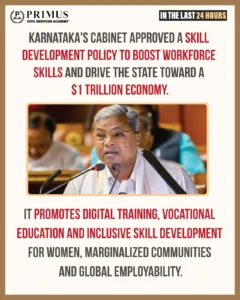
Relevance to UPSC
GS Paper III: Economy (Employment & Technology)
- Connects with themes of employment generation, skill–market mismatch, and how skilling contributes to economic growth and productivity.
- Speaks to technological adoption in governance (use of AI, digital platforms) in the skill development sector.
More about the News
- The Karnataka cabinet has approved the Karnataka State Skill Development Policy 2025-2032 with an outlay of about ₹4,432 crore to consolidate and streamline skilling efforts.
- The policy aims to leverage digital tools, AI and an integrated framework for training, assessment, guidance, and linkages with industry, to make Karnataka a talent hub.
- It also emphasizes vocational education integration, inclusivity (women, marginalized groups) and global mobility of workforce (through certifications and migration support).
Karnataka State Skill Development Policy 2025-2032
The Karnataka State Skill Development Policy 2025-2032 aims to enhance workforce capabilities and align them with the state’s vision of becoming a $1 trillion economy. By leveraging technology, inclusivity, and industry partnerships, it seeks to create a future-ready skilled workforce. Strengthening skill development is essential to ensure sustainable economic growth, employment generation, and global competitiveness.
Features of the Policy
- Digital & AI Integration: Use of AI, online platforms, and e-learning tools for training and assessment.
- Inclusivity: Focus on women, marginalized groups, differently-abled, and rural youth.
- Industry Linkage: Partnership with industries for internships, placements, and curriculum design.
- Certification & Recognition: Standardized certification to improve global employability of trained workers.
- Cluster Development: Establish skill hubs and training centers in regional clusters for targeted interventions.
Major Focus Areas
- Vocational Education Integration: Strengthening TVET (Technical and Vocational Education & Training).
- Upskilling & Reskilling: Continuous skill development in emerging technologies like AI, robotics, and renewable energy.
- Entrepreneurship Development: Encouraging self-employment and startup ecosystem through training programs.
- Global Workforce Mobility: Aligning training with international standards to enhance overseas opportunities.
- Monitoring & Evaluation: Use of data-driven frameworks for assessing outcomes and improving program efficiency.
Need for the Policy
- Employment Generation: To reduce unemployment. e.g., skill training in IT and manufacturing sectors in Bengaluru.
- Industry Readiness: Bridging skill gaps. e.g., automotive skill hubs in Pune-Karnataka clusters.
- Economic Competitiveness: Support $1 trillion economy goal. e.g., global-standard IT training for export-oriented jobs.
- Inclusive Growth: Empower marginalized communities. e.g., vocational training for women in rural districts like Raichur.
- Innovation & Entrepreneurship: Encourage startups. e.g., incubation centers in Mysuru and Hubli for tech-based MSMEs.
Drawbacks in the Policy
- Over-reliance on digital platforms may exclude remote rural areas with limited connectivity.
- Implementation challenges due to coordination across multiple departments and industries.
- Limited focus on informal sector workers who form a significant part of the workforce.
- Monitoring and evaluation mechanisms may be underdeveloped initially.
- Risk of mismatch between training content and actual industry requirements.
Way Forward
- Strengthen infrastructure for rural and remote training centers.
- Enhance public-private partnerships for better industry alignment.
- Include informal sector and gig workers in skill development programs.
- Invest in continuous monitoring, evaluation, and feedback mechanisms.
- Promote entrepreneurship and local innovation through incubation centers and mentorship.
Prelims MCQ
Q. Consider the following statements about Karnataka State Skill Development Policy 2025-2032:
1. It emphasizes digital tools, AI, and e-learning for skill development.
2. The policy focuses exclusively on urban youth and IT sectors.
3. Certification and industry linkages are key components of the policy.
Which of the statements is/are correct?
A. 1 and 2 only
B. 1 and 3 only
C. 2 and 3 only
D. All of the above
The policy emphasizes digital/AI tools (1) and includes certification and industry partnerships (3). Statement 2 is incorrect as the policy targets inclusivity, including rural youth and marginalized groups.
Mains Question
Q. The Karnataka State Skill Development Policy 2025-2032 seeks to create a future-ready workforce for economic growth and global competitiveness. Critically examine its features, focus areas, challenges, and measures needed to ensure effective implementation.




